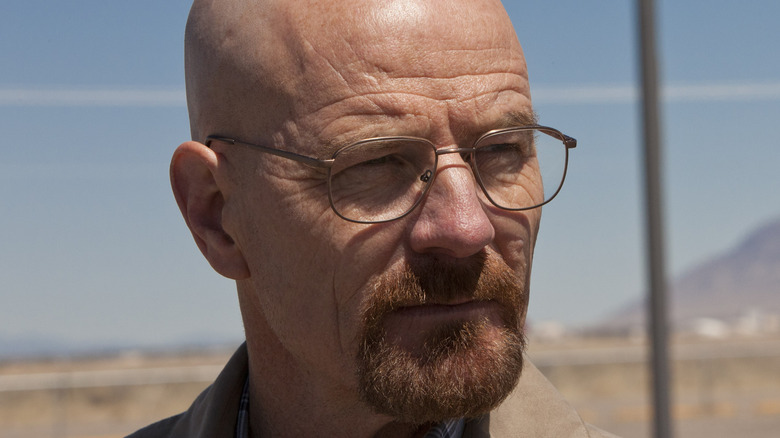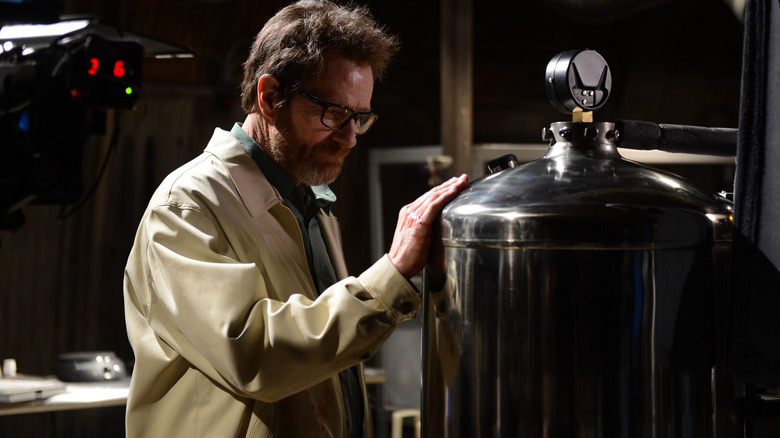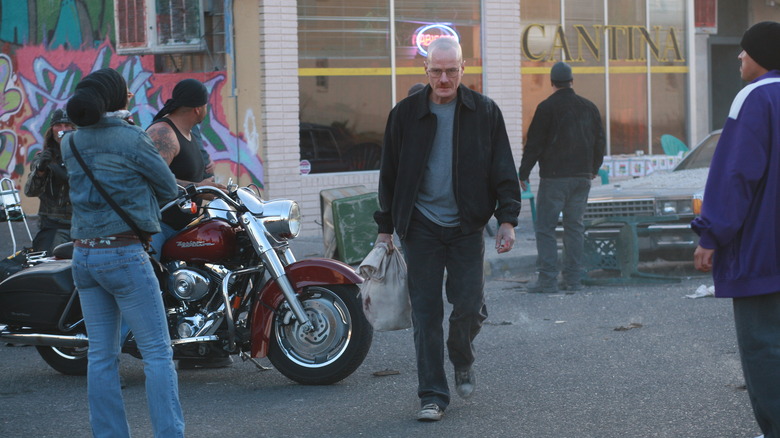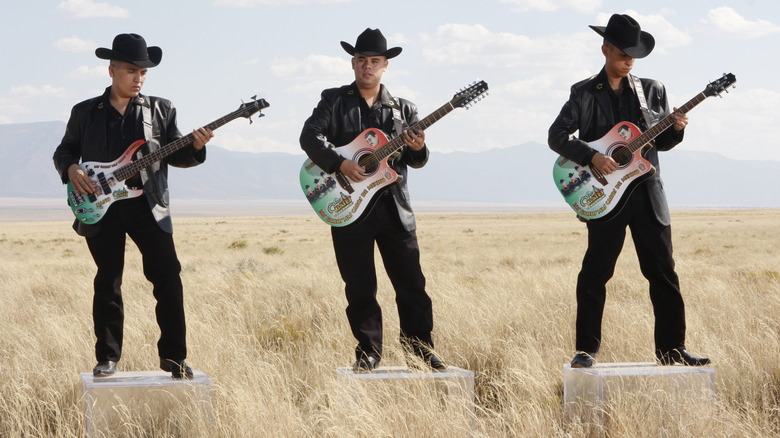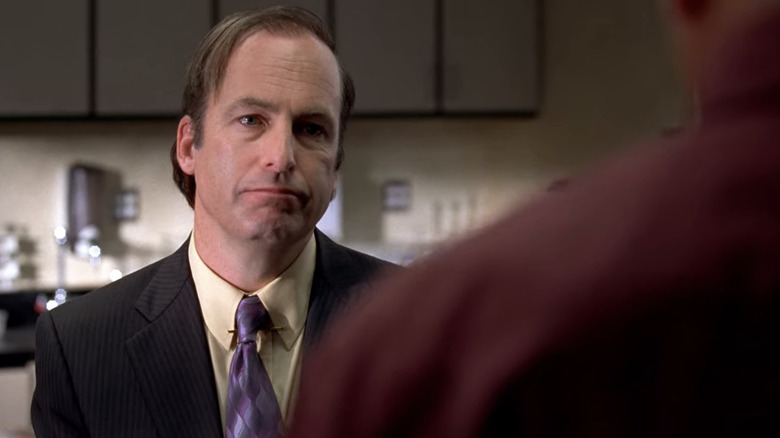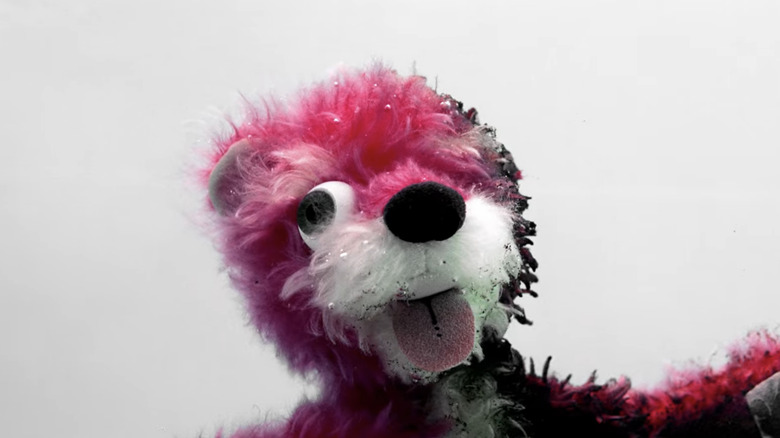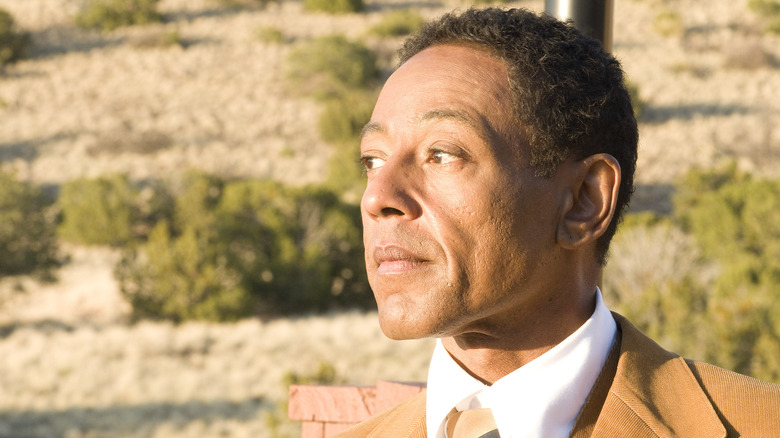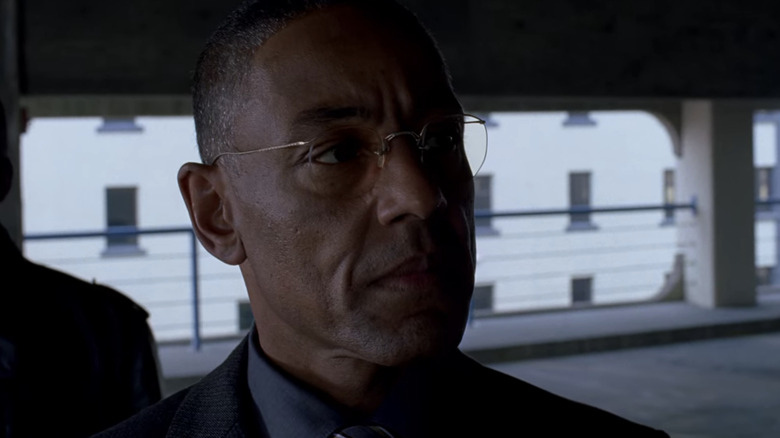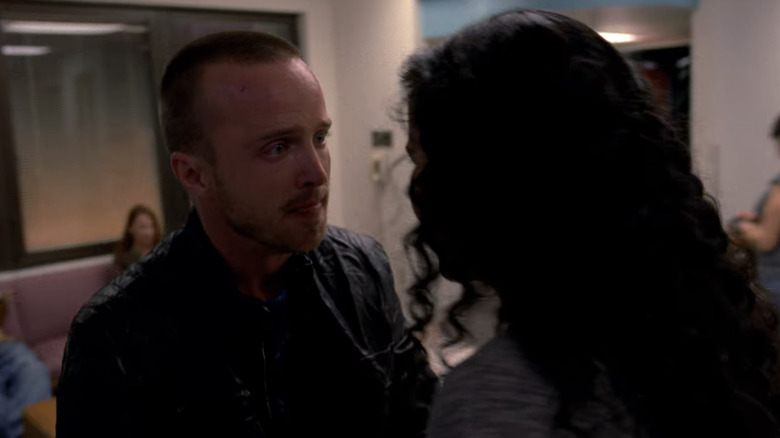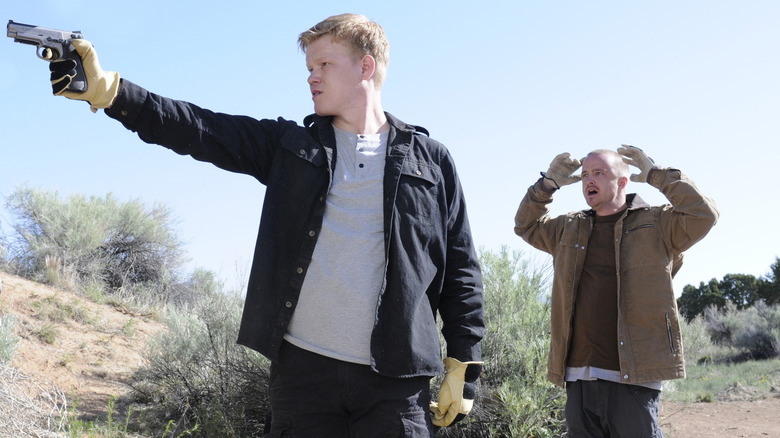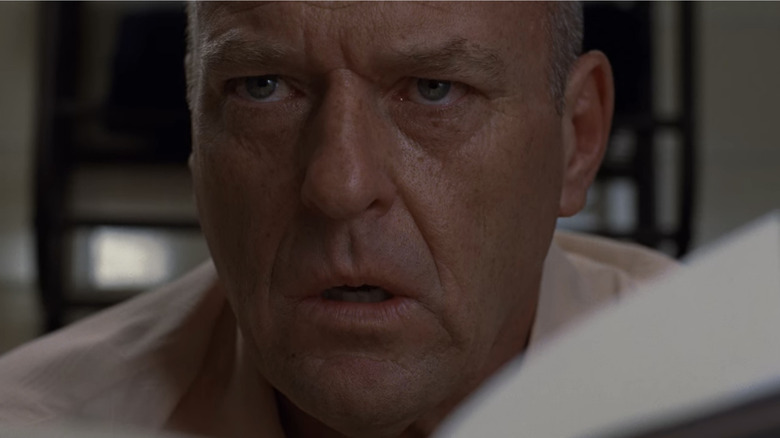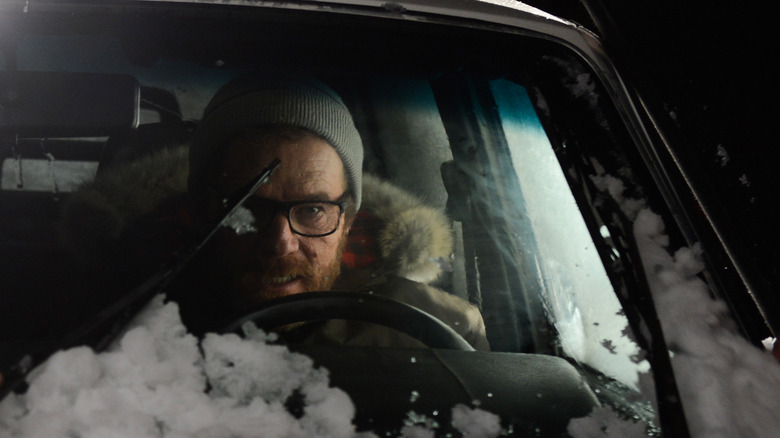Confusing Moments In Breaking Bad Explained
"Breaking Bad," Vince Gilligan's epic television series about a chemistry teacher turned drug kingpin, is a lot of things. It's a neo-Western, a crime drama, a dark comedy, a bone-deep character study of an evil man allowed to finally show his true colors, and an indictment of the American medical system, among others. Perhaps more than anything else, though, it's a show about chain reactions — how one decision inevitably follows another. From Walter White (multiple Emmy-winner Bryan Cranston) receiving his cancer diagnosis in the series premiere to him laying waste to a neo-Nazi compound in the finale, everything that happens comes as a direct result of what came before, step by step and link by link.
Of course, the show isn't merely a series of math problems pointing to one correct answer. Gilligan and his collaborators understood that contaminants — whether a stray fly or one man's bottomless anger toward the world — can turn an orderly procedure into something dangerous, or even disastrous. Like its main character, "Breaking Bad" is meticulous, exacting, and often cruel, but always compelling. It's a show that expects its audience to pay attention, but there are some moments that even die-hard fans might still be confused or have lingering questions about. Let's take a look at some of the most confusing moments in "Breaking Bad."
Over how long does the show take place?
The story of "Breaking Bad" runs across just over two tumultuous years in the life of Walter White and those around him. In the premiere episode, he is made his special birthday breakfast by his wife Skylar (Anna Gunn) — a plate of eggs with his age spelled out in bacon, which is 50. This is Walt as a mild-mannered family man teaching high school chemistry. He's clearly sick, but he hasn't yet received the terminal lung cancer diagnosis that will destroy the lives of everyone around him. By the Season 5 premiere "Live Free or Die," in a flash-forward to what will be the series finale, a far more grizzled Walt orders a plate of eggs and bacon. He is alone, so he makes his age himself: 52.
This can be confusing for a few reasons. For one, the series itself lasted five seasons, with Season 5 split into two parts that aired in 2012 and 2013. Most non-animated television shows will more-or-less reflect the passage of time as it is in real life, but "Breaking Bad" often begins its season premieres mere moments after the events of the previous finale (making it optimal as a binge-watch). More than that, though, the show is so packed with plot and incident that it's at times difficult to believe the first four seasons happen in just one year, yet Walt's 51st birthday doesn't happen until the Season 5 episode "Fifty-One." From Walt's diagnosis, operation, and remission; to Hank recovering from multiple gunshot wounds after his attack by the cousins; to the beginning and explosive end of Walt's war with Gus Fring, this was apparently one hell of a year.
How does Walt blow up Tuco's office?
The "Breaking Bad" Season 1 episode "Crazy Handful of Nothin'" marks a turning point in the series. It's the premiere of Walt's signature bald look, as he shaves his head in anticipation of it falling out from chemotherapy treatment. It's also the first time he adopts the street name Heisenberg. It is also the first of many times that he makes a dangerous move against his enemies and succeeds through sheer audacity. After his former student and partner in crime Jesse Pinkman (Aaron Paul) is beaten up and has a pound of meth stolen by local cartel lieutenant Tuco Salamanca (Raymond Cruz), Walt visits Tuco's office to demand restitution. When Tuco laughs in his face, Walt takes a chunk of what appears to be more crystal meth and throws it to the ground, rocking the office and shattering windows with a concussive force.
So what exactly was that? Walt's answer is fulminated mercury, "a little tweak of chemistry." Mercury fulminate is indeed a highly sensitive explosive agent, most often used in powder form. But could such a small amount cause such a large explosion? A 2013 episode of "Mythbusters" dedicated to "Breaking Bad" tried to recreate the scene, but found that mercury fulminate only detonated when silver fulminate was added. Even then, it would take a much larger amount to create a comparable explosion to what's seen on the show.
What is the music video from Negro y Azul?
"Breaking Bad" is known for its striking opening scenes, whether it's Walt walking naked through a grocery store in a "fugue state" or a seemingly unrelated scene of a young boy trapping a tarantula in a glass jar. Season 2's "Negro y Azul" opens with a three-and-a-half-minute music video by the Mexican group Los Cuates de Sinaloa, singing a ballad to the "gringo" whose pure blue crystal meth has cut into the cartel's business north of the border and is now stoking demand all the way down to Michoacan. But the cartel isn't going to forgive this disrespect; the song's final lyric translates to "But that homie's dead, he just doesn't know it yet."
The song, with music and Spanish lyrics by songwriter Pepe Garza, is an example of a narcocorrido – a subgenre of Mexican popular music that uses traditional song forms and instruments to tell stories of the ongoing cartel wars. As drug violence has left its mark on the country and culture over the last several decades, the narcocorrido has grown in popularity on both sides of the border (via Mother Jones). The ballad of Heisenberg (AKA "Negro y Azul") may have been the first example of the form to be featured on a mainstream American television show (per The Los Angeles Times). The story depicted in the song is obviously fiction, but the group performing it is very much a real band, and an appropriate one; their name translates to "the friends of Sinaloa," meaning the Sinaloa cartel.
How does Saul find Walt?
"Breaking Bad" Season 2 introduces several pivotal characters, starting with criminal lawyer Saul Goodman (Bob Odenkirk). Walt and Jesse hire the flamboyant attorney when Jesse's friend Badger (Matt Jones) is arrested while dealing their meth. The trio gets off to a somewhat bumpy start when Walt and Jesse drag Saul out to the desert to threaten him, but he proves to be a keen and savvy legal mind. At the end of the episode, he manages to track down Walt at school and makes his pitch to be the Heisenberg empire's go-to counselor.
The scene works as a way to illustrate both how resourceful Saul is and how sloppy Walt and Jesse have been. If Saul is able to track Walt down, after all, the police must not be far behind. But the show doesn't explain exactly how Saul finds out Heisenberg's identity, other than to cite his "P.I.," who remains nameless because the character who actually did the legwork, Mike Ehrmentraut (Jonathan Banks), didn't exist yet. Mike makes his "Breaking Bad" debut later in the season and becomes integral to both the series and its 2015 spin-off "Better Call Saul." That series, a prequel following Saul (originally Jimmy McGill) in the years before he met Walt and Jesse, revisits the classroom meeting in the Season 6 episode "Breaking Bad," revealing that Mike was the one who tracked down Walt's identity. He also advised Saul not to get involved with him — advice that was tragically not followed.
Wayfarer 515
The tragic saga of Wayfarer flight 515 is fairly straightforward on paper. Jesse's landlord-turned-girlfriend Jane Margolis (Krysten Ritter), a recovering heroin user, relapses and takes Jesse with her. One night as they are both in a drug-induced stupor, Walt breaks into Jesse's apartment to grab a stash of money. Jane begins to throw up in her sleep, and Walt has the opportunity to turn her over and save her life, but he chooses not to, and Jane chokes to death. Her father Donald (John De Lancie), whom Walt had met by chance the night Jane died, takes a leave of absence from his job as an air traffic controller, but when he comes back he is still clearly devastated by his loss and not in his right mind. A lapse in concentration results in a Wayfarer Airlines flight colliding with a small passenger plane in the airspace above Walt's house, raining debris and bodies into his pool and onto his driveway.
That is more or less the sequence of events occurring in the season's final two episodes, but leading up to that, each episode opens with cryptic black-and-white scenes of the aftermath of the crash — flash-forwards that suggest something awful happening to Walt and his family. We see a pink teddy bear fished out of the pool by someone in a hazmat suit and two body bags in the Whites' driveway. In the end, it turns out that these pictured events are in fact a large, fiery symbol of the evil that Walt has put out into the world.
Gus' mysterious past
Walt meets his match at the end of "Breaking Bad" Season 2 with the introduction of Gus Fring (Giancarlo Esposito), the straight-laced owner of a local fast food chain in public and a ruthless drug lord in private. Gus' icy demeanor, strict discipline, and capacity for brutal violence stand in stark contrast to Walt, who labors under the delusion that he is still a good man at the end of the day. The battle between Walt and Gus takes up most of Seasons 3 and 4, and the repercussions of Walt's eventual victory carry through the rest of the series.
However, we learn very little over the course of the series and "Better Call Saul" about who Gus Fring really is and where he comes from. We know that he is Chilean, and based on his age and the precision with which he conducts his life, it's possible he was an officer or agent in the brutal military dictatorship of Augusto Pinochet. Two scenes provide the closest we get to an origin story. In Season 4, there's a flashback to the 1980s in which cartel head Don Eladio and his lieutenant Hector Salamanca (Steven Bauer and Mark Margolis, both from "Scarface") murder Gus' partner Max but spare his life because of who he was in Chile. In the same episode, we also get an interrogation scene where Walt's DEA agent brother-in-law Hank (Dean Norris) asks if "Gustavo Fring" is his real name. The unexpected question marks one of the few times in the series that Gus appears rattled.
Gus' Sixth Sense
It's his sense of poise and clarity that appears to give Gus Fring a sixth sense, warning him of danger when nothing seems out of the ordinary. One of the most notable moments of this extrasensory perception is in "Breaking Bad" Season 4 when his war with Walt builds to a fever pitch. Walt has rigged up a small bomb and planted it under Gus' car — a sensible Volvo station wagon — parked in the hospital garage. He watches through binoculars from a nearby rooftop as Gus and his henchmen Tyrus (Ray Campbell) and Dennis (Mike Batayeh) walk toward the car. Suddenly, Gus stops. He walks to the edge of the garage and scans the Albuquerque skyline as Walt hides, quietly willing Gus to go to the car so that he can detonate the bomb. Gus steps back and exits the garage, leaving his car behind.
This is a moment that took many viewers aback when it first aired, and it continues to rile fans years later. What could have possibly tipped Gus off that something was wrong? There's no clear reason, and other than the briefest moment when his glance over the skyline holds in one spot slightly too long, there's no indication that he saw Walt. Was it simply bad writing, drawing out suspense at the expense of credulity? Esposito, speaking at a convention in 2014, credited Gus' incredible intuition: "He didn't know there was a bomb, but he knew that something was wrong" (via JammedFull on YouTube).
How did Walt poison Brock?
One of the most confusing questions in all of "Breaking Bad" is how exactly Walt poisoned Brock (Ian Posada), the young son of Jesse's girlfriend Andrea (Emily Rios) in Season 4. By the moment in Season 4 when Brock is rushed to the hospital with mysterious symptoms, Walt and Jesse are no longer partners. Jesse discovers that his cigarette hiding a vial of poisonous ricin is missing, and reasonably assuming that Walt stole it, attacks him. Later, however, the cigarette turns up inside Jesse's Roomba, having apparently been vacuumed up at some point earlier. Walt points out that Gus has the capacity to kill a child, winning a vulnerable Jesse back to his side.
The thing is, Jesse's right. Walt really did steal the ricin cigarette via the sticky fingers of Huell (Lavell Crawford), Saul's bodyguard, and he really did poison Brock — not with ricin, but with lily of the valley from his backyard (as seen in the final shot of the season). He then put the stolen cigarette into the dustbin of the Roomba to further gaslight Jesse, who now feels guilty that he accused and assaulted Walt. It's an amazing bit of subterfuge, and one that the show doesn't play entirely fair with. The moment when Huell frisks Jesse seems to have no moment when he could have reasonably lifted the cigarette out of its package, and the logistics of Walt getting to Brock and poisoning him are never even addressed. At this point, the series is clearly more interested in why it happens than how.
How does the train heist work?
After killing Gus and Hector in one explosive move, Walt stands alone in the Albuquerque meth game. But being the king presents its own problems, and he, Jesse, Mike, and newcomer Todd (Jesse Plemons) face a supply crisis, specifically of the crucial chemical ingredient methylamine. When Walt and Jesse worked in Gus' superlab, the methylamine was procured via theft from the warehouses of German conglomerate Madrigal Electromotive, with an assist by executive Lydia Rodarte-Quayle (Laura Fraser). But after Gus' death, the extra scrutiny placed on Madrigal has made that impossible. Their solution? Rob a train carrying thousands of gallons across the country.
It's one of the most audacious sequences the show ever attempts — a thrilling Western spectacle involving an underground tank and a stalled pickup truck driven by Saul's associate Kuby (Bill Burr). As with the idea to use a magnet to erase the computer seized from Gus' office earlier in the season, inspiration strikes Jesse while Walt and Mike are arguing. While the train is stopped due to Kuby's stalled truck, Walt, Jesse, and Todd siphon off 1,000 gallons of methylamine solution and replace the weight via 900 gallons of water, due to water's greater weight. According to the Weak Interactions blog, the show's math checks out. The sequence works as "Breaking Bad" in miniature, combining science, suspense, and a well-made plan that's executed perfectly until an unexpected factor — an inconvenient witness and a trigger-happy Todd — throw everything into disarray.
Why does Walt keep Gale's book?
"Breaking Bad" Season 5 was split into two sections, one airing in 2012 and the other a year later. The mid-season finale, "Gliding Over All," is a doozy. Without a central lab to work from, Walt and Jesse develop a mobile lab that works in random people's homes under the cover of a pest control business — one of Saul's many shell companies. The episode covers three months of peace and prosperity both in business and at home, as Skyler brings home Walt Jr. and Holly to reunite the family. All seems to have finally worked out, and the victory Walt declared after Gus' death is finally confirmed. That is, until Hank goes to the bathroom while at Walt's house and discovers a copy of Walt Whitman's "Leaves of Grass" inscribed to Walt by Gale Boetticher (David Costabile), the man the DEA believed to be Heisenberg. Suddenly, it all clicks into place.
So why did Walt keep such an incriminating piece of evidence in his house? Because he "won." Creator Vince Gilligan's classic pitch for the show was turning "Mr. Chips into Scarface," and one of the revealing things about that line is the way that movies inform Walt's worldview. Before his life of crime, the only things Walt knew about being a criminal came from movies, and even as he journeys further into violence and other unforgivable acts, there's still a sense that he thinks of his enemies like film villains — that once they're dead, they're gone forever. But that's not the case, either in life or in Gilligan's New Mexico, where every action has a reaction.
Was the ending a fantasy?
At the end of "Breaking Bad," in the Season 5 finale "Felina," Walt emerges from his New Hampshire exile to settle all his old scores. He visits his former business partners Gretchen and Elliot (Jessica Hecht and Adam Godley), not for revenge, but to use their wealth to launder his drug money for his children. He sees Skyler one last time, not to gain forgiveness, but to confess what we knew all along: He did it all for himself. He arranges a meeting through Lydia (whom he poisons with the vial of ricin) with Uncle Jack (Michael Bowen) and the neo-Nazis who took over his business and have held Jesse prisoner for months. Then he takes out the lot of them with a makeshift remote control Gatling gun. He frees Jesse, who strangles psychopath Todd to death and escapes into the night. Mortally wounded by a stray bullet, Walt finally dies, surrounded by his terrible works.
It's all very neat and tidy — a little too tidy for some viewers, who theorized that what we see is actually a fantasy being lived by Walt as he lies dying in a New Hampshire cabin, or sits inside the frozen car from the episode's opening. Things in the episode do seem to happen exactly as Walt plans them, which runs somewhat counter to the frantic improvisation that fuels many of the show's best moments. However, there's no overt indication that what we see in the episode is fake. The events are further confirmed by the sequel movie "El Camino," which tracks the rest of Jesse's escape, and by the final season of "Better Call Saul."
